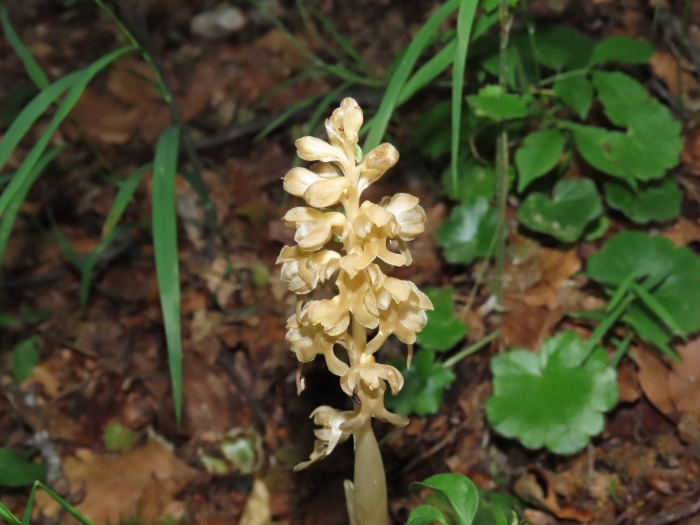Bird’s-Nest Orchid
(Neottia nidus-avis)
Bird’s-Nest Orchid (Neottia nidus-avis)
/
/

Emanuele Santarelli
CC BY-SA 4.0
Image By:
Emanuele Santarelli
Recorded By:
Copyright:
CC BY-SA 4.0
Copyright Notice:
Photo by: Emanuele Santarelli | License Type: CC BY-SA 4.0 | License URL: http://creativecommons.org/licenses/by-sa/4.0/ | Rights Holder: Emanuele Santarelli | Publisher: iNaturalist | Date Created: 2020-06-06T16:55:34-07:00 |






















Estimated Native Range
Summary
Neottia nidus-avis, commonly known as the bird’s-nest orchid, is a perennial herbaceous plant that lacks chlorophyll and is therefore non-photosynthetic. It is native to temperate deciduous forests, particularly beech and oak woodlands, across Europe, Russia, and parts of the Middle East. The bird’s-nest orchid typically grows to about 16 inches tall and is notable for its clusters of up to 60 small, beige-brown flowers that bloom from May to June. The flowers, though not brightly colored, are intricate and have a unique charm. This orchid relies entirely on a symbiotic relationship with mycorrhizal fungi for its nutrients.
The bird’s-nest orchid is valued for its unusual appearance and ecological role in forest ecosystems. It is often used in shade gardens or naturalized woodland settings, where it can add interest due to its distinctive growth habit and contribution to biodiversity. It prefers shady conditions, moist but well-drained calcareous soils, and is typically found in the leaf litter of forest floors. While it does not require direct sunlight, maintaining the right soil conditions and ensuring the presence of the necessary fungi is crucial for its survival. In cultivation, it is relatively low-maintenance once established. However, it is rarely cultivated due to its specialized mycorrhizal requirements and is more often appreciated in its natural habitat. The main threats to this species include habitat destruction and the collection of wild specimens, which has led to its near-threatened conservation status in some regions, such as the UK.CC BY-SA 4.0
The bird’s-nest orchid is valued for its unusual appearance and ecological role in forest ecosystems. It is often used in shade gardens or naturalized woodland settings, where it can add interest due to its distinctive growth habit and contribution to biodiversity. It prefers shady conditions, moist but well-drained calcareous soils, and is typically found in the leaf litter of forest floors. While it does not require direct sunlight, maintaining the right soil conditions and ensuring the presence of the necessary fungi is crucial for its survival. In cultivation, it is relatively low-maintenance once established. However, it is rarely cultivated due to its specialized mycorrhizal requirements and is more often appreciated in its natural habitat. The main threats to this species include habitat destruction and the collection of wild specimens, which has led to its near-threatened conservation status in some regions, such as the UK.CC BY-SA 4.0
Plant Description
- Plant Type: Herb
- Height: 0.5-1.5 feet
- Width: 0.5-1 feet
- Growth Rate: Slow
- Flower Color: Brown, Cream
- Flowering Season: Spring, Summer
- Leaf Retention: Deciduous
Growth Requirements
- Sun: Part Shade
- Water: Medium
- Drainage: Medium
Common Uses
Low Maintenance, Potted Plant, Rock Garden
Natural Habitat
native to temperate deciduous forests, particularly beech and oak woodlands, across Europe, Russia, and parts of the Middle East
Other Names
Common Names:
Scientific Names: , Neottia nidus-avis, Distomaea nidus-avis, Epipactis nidus-avis, Helleborine nidus-avis, Helleborine succulenta, Listera nidus-avis, Malaxis nidus-avis, Neottia macrostelis, Neottia nidus-avis f. brachystelis
GBIF Accepted Name: